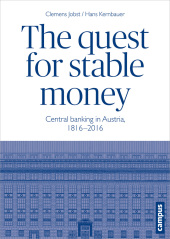 Neuerscheinungen 2016Stand: 2020-02-01 |
Schnellsuche
ISBN/Stichwort/Autor
|
Herderstra▀e 10
10625 Berlin
Tel.: 030 315 714 16
Fax 030 315 714 14
info@buchspektrum.de |

Christopher J. Anderson, Michaela Beichtbuchner, Ingrid Haussteiner, Clemens Jobst, Hans Kernbauer
(Beteiligte)
The quest for stable money
Central banking in Austria, 1816-2016
▄bersetzung: Anderson, Christopher J.; Beichtbuchner, Michaela; Haussteiner, Ingrid u. a.
2016. 320 S. div. Abbildungen und Schaubilder. 229 mm
Verlag/Jahr: CAMPUS VERLAG 2016
ISBN: 3-593-50535-5 (3593505355)
Neue ISBN: 978-3-593-50535-0 (9783593505350)
Preis und Lieferzeit: Bitte klicken
Caught up in the costly Napoleonic wars, Austria went into sovereign default in 1811. Five years on, the public authorities founded a national bank to be financed and run by private shareholders, the idea being that an independent bank would help rebuild trust in money.
During the 200 years that followed, the Nationalbank emerged from the treasury┤s banker of choice into a central bank, and from a private stock corporation into a public institution. Yet the challenges facing today┤s Nationalbank are a surprising echo of the past: How to provide stable money? How far must central bank independence go? How does monetary policy making work in a multinational monetary union? How to provide stable money?
This engaging book provides the first extensive overview of monetary history in Austria, from the Nationalbank┤s predecessor, the Wiener Stadtbanco, to Austria┤s integration into the euro area today.
Table of contents
6 Introduction
12 A first try at monetary autonomy-the Wiener Stadtbanco (1706-1816)
13 Public banks in the 1600s and 1700s-innovative payment services and public debt management
15 A bankrupt sovereign in need of a public bank
23 Paper money and inflation
34 Fragile stability during the Nationalbank┤s formative years (1816-1848)
35 A private stock corporation as a guardian of Austria┤s currency
46 Note-issuing bank of an economically and politically heterogeneous empire
52 The tasks of the Nationalbank
64 Turning from the treasury┤s banker to the banker┤s bank (1848-1878)
65 1848-the revolution accelerates long-term change
70 The return to convertibility proves to be a moving target
81 Taking on a new role in the financial system
88 Monetary policy after 1866: from fiscal to monetary dominance against all odds
96 200 years of monetary policy in pictures
112 Two governments, one bank-the Austro-Hungarian monetary union (1878-1914)
114 A separate note-issuing bank for Hungary?
124 Return to a stable external value
131 Conducting business in a large empire
142 World War I and the collapse of monetary union (1914-1919)
143 War preparations and the initial weeks of conflict
144 State financing and central bank policy during the war
150 The end of the monarchy and the joint currency
152 Hyperinflation and a new currency (1919-1931)
153 Hyperinflation and stabilization
156 The League of Nations loan
161 Central bank policy under foreign control, 1923-1929
167 The schilling replaces the crown
174 The Creditanstalt crisis, the Great Depression and World War II (1931-1945)
176 The Creditanstalt crisis
183 Restructuring of banks
186 Stable exchange rate, stagnating economy
189 Liquidation of the OeNB, the reichsmark replaces the schilling
194 Schilling reinstatement and economic miracle (1945-1971)
195 The schilling returns
214 Dynamic catch-up process and stability risks
222 Austria┤s hard currency policy (1971-1999)
223 The crisis of the Bretton Woods system
225 Exchange rate policy as an anti-inflation policy
234 Financial market liberalization, EU accession and preparations for the euro
242 A single European currency-the OeNB as a Eurosystem central bank (1999-2016)
244 Monetary policy may change, but the objective does not
254 The common monetary policy, 1999 to 2015
257 New instruments to ensure financial stability
268 Conclusion
274 Currencies
276 Notes
298 References
311 Sources
312 List of tables, charts and maps
312 Photo credits
313 Index
317 Acknowledgments
Caught up in the costly Napoleonic wars, Austria went into sovereign default in 1811. Five years on, the public authorities founded a national bank to be financed and run by private shareholders, the idea being that an independent bank would help rebuild trust in money.
During the 200 years that followed, the Nationalbank emerged from the treasury┤s banker of choice into a central bank, and from a private stock corporation into a public institution. Yet the challenges facing today┤s Nationalbank are a surprising echo of the past: How to provide stable money? How far must central bank independence go? How does monetary policy making work in a multinational monetary union? How to provide stable money?
This engaging book provides the first extensive overview of monetary history in Austria, from the Nationalbank┤s predecessor, the Wiener Stadtbanco, to Austria┤s integration into the euro area today.


